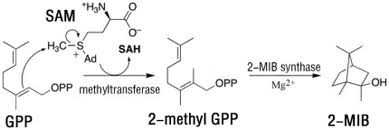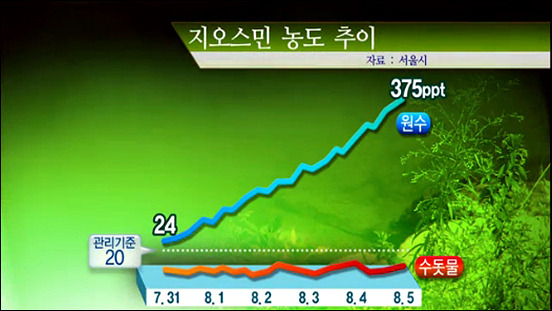식품 ≫ 안전성 ≫ 향의 역할
지오스민은 시골냄새다. 악취일까 향취일까 ?
다양한 냄새
- 나이와 체취
- 물의 냄새 : 지오스민
- Geosmin은 Greek for "earth odour"에서 유래
- 2-MIB, 지오스민 모두 터텐에서 합성된 물질
It is formed by microorganisms in the soil, particularly Streptomyces. Although the smell of geosmin was first identified in 1891, the isolation and structure of the geosmin molecule responsible for it was only reported in 1965, and its synthesis in 1968. It is even more recently that its biosynthesis has been understood. Geosmin biosynthesis begins in farnesyldiphosphate (FPP), a key building block in sterol and sesquiterpene biosynthesis. An enzyme called germacradienol-geosmin synthase (GGS) contains two very similar catalytic domains. One domain converts FPP into germacradienol, which diffuses into the second domain close by, where the conversion to geosmin is completed.
colourless liquid, with a boiling point of 270°C.


2-methylisoborneol (2-MIB)
- 역가가 매우 낮다. 물에서 0.0082-0.018 ppb
천연향이 진한 법이다
natural (-) form has a significantly stronger smell. 합성으로는 (+)형도 만들수 있는데 이것은 11배나 강도가 약하다
- 워낙 소량이라 냄새의 제거가 쉽지는 않지만
acid destroys it; it has also been found that photocatalysts based on titanium dioxide (TiO2) can also destroy water-borne geosmin.

악취로 작용하는 경우가 많다
-소년조선, 2011.12.16)
일부 수도권 가정에 공급된 수돗물에서 1주일 이상 흙냄새가 났다고 한다. 다행히 냄새의 원인은 쉽게 파악된 모양이다. 지나치게 더웠던 지난가을 동안 북한강에 번성한 녹조류(綠藻類)가 문제였다. ‘흙냄새 수돗물’의 원인은 녹조류가 내뿜는 유기물질 지오스민(geosmin)이었다. 실제로 팔당 취수장에서 측정한 지오스민 농도가 270ppt(1ppt는 1조분의 1)를 넘은 경우도 있었다고 한다.
물론 흙냄새 나는 수돗물을 정상이라고 할 순 없다. 그런데 이번에 문제가 된 흙냄새는 사실 우리에게 아주 익숙한 것이다. 건조한 날씨가 계속되다가 갑자기 소나기가 쏟아질 때 시골 마당에서 나는 냄새가 바로 흙냄새다. 바짝 마른 밭을 갈아엎거나 잡초를 뽑을 때도 흙냄새가 난다. 어린 시절을 시골에서 보낸 이들은 흙냄새를 맡으며 지난날을 그리워하기도 한다.
하지만 규산염이 주성분인 흙 자체에서 냄새가 나는 경우는 드물다. 붉은색 산화철이 많은 진흙에서 나는 쇠(金) 냄새는 너무 옅어서 쉽게 알아차리기 어렵다. 실제로 흙에서 나는 냄새는 대부분 지오스민 냄새다. 지오스민을 내뿜는 건 스트렙토미세스 등의 박테리아. 방선균류(放線菌類)에 속하는 이 박테리아는 흙속에 살면서 곰팡이처럼 균사체와 포자를 만들어낸다.
인간은 진화 과정을 거치며 지오스민에 매우 민감한 후각을 갖고 있다. 공기 중 지오스민 농도가 5ppt만 넘어도 곧바로 흙냄새를 알아차린다. 5ppt는 측정이 어려울 정도로 옅은 농도다. 사람의 코가 화학 실험실에서 사용하는 고가의 분석 장비보다 뛰어난 성능을 발휘하는 셈이다.
민물에서 광합성을 통해 번성하는 남조류(藍藻類)나 녹조류(綠藻類)도 지오스민을 내뿜는다. 수돗물에서 나는 흙냄새는 대부분 그런 식물성 플랑크톤에 의해 발생하는 지오스민이 원인이다. 다행히 지오스민은 인체에 크게 해롭지 않은 것으로 알려져 있다. 하지만 수돗물에서 나는 흙냄새를 좋아할 사람은 없다. 수돗물을 생산하는 정수장에서 지오스민의 농도를 20ppt 이하로 관리하는 것도 소비자가 불쾌감을 느끼지 않도록 하기 위한 조치다.
지나치게 더운 날, 강이나 호수의 물에 식물성 플랑크톤이 번성하는 녹조 현상이 반가울 리 없다. 강이나 호수에 비료나 인(燐)이 너무 많이 포함된 화학비료가 흘러들어가 발생하는 인공적 부영양화의 경우, 특히 그렇다. 가을 날씨가 아무리 비정상적으로 더웠다 해도 깨끗한 1급수를 자랑하던 북한강에서 녹조가 발생한 건 심각한 문제다.
정수장에서 극히 적은 양의 지오스민을 제거하기란 쉽지 않다. 방법이 전혀 없는 건 아니다. 물을 끓이거나 신맛이 나는 레몬즙을 넣어주면 지오스민이 분해돼 흙냄새가 사라진다. 녹조 현상이 심각한 지역에서 찬물을 마실 때 레몬 조각을 넣는 건 그 때문이다. 낯선 냄새가 난다고 무조건 두려워할 필요는 없다. 화학적 지식을 활용, 문제를 간단하게 해결하는 지혜를 발휘하면 될 일이다.
여러 냄새에 관여된다
Geosmin (and also 2-methylisoborneol , which also has an undesireable taste) is often responsible for unpleasant tastes in water supplies. Cyanobacteria (blue-green algae) and actinobacteria release geosmin when they die, and this can be absorbed by bottom-feeding freshwater fish. This is a particular problem in parts of the United States, giving off-flavours to fish (particularly catfish (photo, below), carp and mullet) and clams. Geosmin is made odourless by acid, so these fish are often eaten with lemon, leading to recipes like clam chowder with lemon zest, blackened Cajun catfish or grilled catfish with lemon juice.
Geosmin is a major contributor to the smell and flavour of beetroot, a variety of Beta vulgaris. Not everyone likes the smell, and since geosmin levels vary between cultivars, selective breeding can produce varieties with a bland taste designed to appeal to mass markets.
Geosmin and the related molecule dehydrogeosmin (structure, right) are responsible for the musty smell of some plants, especially certain cacti.
In recent years, notably 2002, French wine growers have been concerned about the presence of a rather musty smell in some young wines, which was quite distinct from the usual "musty cork" smell due to 2,4,6-trichloroanisole. Geosmin was identified as the culprit in these wines using gas chromatography-mass spectrometry, specifically the (-) isomer. Corks or the wood of barrels were excluded as the source of the geosmin, as the wines had been stored in stainless steel containers or bottles with metal stoppers. Geosmin was then detected in some grape juices prior to fermentation, and it transpired that geosmin was formed on rotten grapes through the combined action of both the Botyris cinerea and Penicillium expansum fungi
흙 냄새는 건강에 좋다
피톤치드
전남지역의 휴양림 토양에서 정서 안정과 우울증에 효과가 있는 지오스민이 다량 생성되는 것으로 나타났다. 전라남도 보건환경연구원은 흙길이 조성된 광양 백운산과 고흥 팔영산 등 휴양림 6곳의 토양을 조사한 결과 지오스민 성분이 검출됐다고 2012.8. 2일 밝혔다.
지오스민 생성량은 축령산(136.1㎍/㎏), 팔영산(62.0㎍/㎏), 우드랜드(38.5㎍/㎏) 순으로 편백림 토양에서 높게 나타났다. 소나무 토양은 백아산(41.2㎍/㎏), 백운산(15.7㎍/㎏), 죽녹원(7.2㎍/㎏) 순으로 나타났다.
지오스민은 무색, 무미의 천연오일로 숲속 토양에서 독특한 흙냄새를 유발해 초조함이나 불안감을 완화해 우울증 치유에 효과가 있는 것으로 알려졌다. 천연항암제, 항생제 성분으로 아토피를 유발하는 진균을 사멸시키기도 한다. 지오스민은 방선균(곰팡이와 비슷한 세균, 토양의 유기물 층에서 지오스민을 생성하는 미생물)에 의해 부엽토가 쌓인 토양의 상층에서 대부분 생성된다. 연구원측은 “편백림 토양에서는 겨울에, 소나무 숲 토양에서는 봄에 짙은 농도를 보였다”고 설명했다.
연구팀은 정서적 안정 효과를 확인하기 위해 지오스민 흡입 전 후 뇌파를 분석한 결과 델타파와 알파파가 증가해 심신이 안정되고 뇌의 이완도와 활성 증가는 물론 집중도는 높아졌다고 밝혔다. 반면 스트레스는 감소하는 경향을 보였다. 전남도보건환경연구원 양수인 폐기물분석과장은 "산림이 치유의 공간이라는 인식변화에 따라 피톤치드에 이어 지오스민 분석을 통해 휴양림의 자연치유 효능을 과학적으로 입증했다"고 설명했다.
낙타는 어떻게 사막에서 오아시스를 찾을까 ?
Professor Keith Chater, of the John Innes Centre in Norwich (UK), was a member of the team that in 2002 sequenced the genome (8000 genes) in Streptomyces coelicolor A3, a bacterium that produces many chemicals, including geosmin. In the following year he reported identifying a protein domain needed for biosynthesis of geosmin. He has suggested that camels can detect the smell of geosmin that had been released by Streptomyces miles away in wet ground, and track the geosmin to find an oasis; in return the camel could carry away and disperse the spores of the Streptomyces bacterium.
생선에 빨리 스며든다
Magligalig et al. demonstrated how quickly water taints can be transferred to fish muscle. They found an exposure of 10 min to 15 ppm 2-pentanone or dimethyl sulfide resulted in significant taint. Recent work by Jirawan and Athapol [26] on the tainting of Nile tilapia by geosmin showed that this earthy taint is acquired in less than two hours when fish are placed in water containing only 5 ng/l geosmin. The fish had to be held in clean water at least 16 days to then eliminate this taint. This very rapid absorption of odorants makes fish very susceptible to picking up taints from their environment.